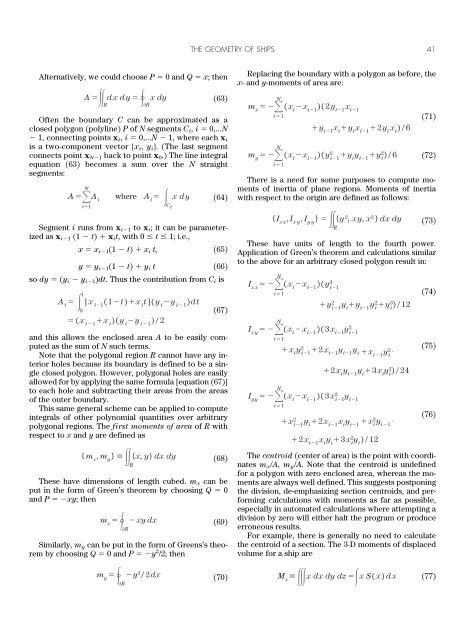The Geometry of Ships
You also want an ePaper? Increase the reach of your titles
YUMPU automatically turns print PDFs into web optimized ePapers that Google loves.
40 THE PRINCIPLES OF NAVAL ARCHITECTURE SERIES<br />
9.3 Planimeters and Mechanical Integration. During<br />
the centuries in which graphical design operations were<br />
so central to ship design, an important traditional tool <strong>of</strong><br />
the naval architect has been an area-measuring mechanical<br />
instrument known as a planimeter. This is a clever<br />
device with a stylus and indicator wheel; when the user<br />
traces one full circuit <strong>of</strong> a plane figure with the stylus, returning<br />
to the starting point, the indicator wheel rotates<br />
through an angle proportional to the area enclosed by<br />
the figure.<br />
More complex versions <strong>of</strong> this instrument, known as<br />
integrators, are able to additionally accumulate readouts<br />
proportional to the moments <strong>of</strong> area and moments<br />
<strong>of</strong> inertia <strong>of</strong> the figure. <strong>The</strong> previous edition <strong>of</strong> this book<br />
contains a mathematical derivation <strong>of</strong> how the planimeter<br />
works. Today, with the great majority <strong>of</strong> area, volume,<br />
weight, and hydrostatic calculations performed by<br />
computer programs, planimeters are likely relegated to<br />
the same dusty drawer as the slide rule.<br />
9.4 Areas, Volumes, Moments, Centroids, and Moments<br />
<strong>of</strong> Inertia. Volume is usually calculated as an integral <strong>of</strong><br />
areas. In the general volume integral<br />
V<br />
<br />
dxdydz,<br />
(57)<br />
Fig. 33 Numerical integration rules. (a) Sum <strong>of</strong> trapezoids. (b)<br />
Trapezoidal rule. (c) Simpson’s first rule (being applied to rather unsuitable<br />
data).<br />
constant, x i x i1 x, and the sum <strong>of</strong> trapezoids<br />
takes the simpler form (the “trapezoidal rule”):<br />
<br />
x0<br />
(55)<br />
... 2y N1<br />
y N<br />
)<br />
Note: <strong>The</strong> trapezoidal rule can be seriously in error if<br />
the function has discontinuities; in such cases, the sum <strong>of</strong><br />
trapezoids will usually give a much more accurate result.<br />
9.2.3 Simpson’s First Rule. When (1) the tabulation<br />
is at uniformly spaced abscissae, (2) the number <strong>of</strong> intervals<br />
is even (number <strong>of</strong> abscissae is odd), and (3) the<br />
function is known to be free <strong>of</strong> discontinuities in both<br />
value and slope, then a piecewise parabolic function can<br />
be a more accurate interpolant. This leads to “Simpson’s<br />
first rule”:<br />
<br />
xN<br />
xN<br />
x0<br />
ydxx /2(y 0<br />
2y 1<br />
2y 2<br />
ydxx /3(y 0<br />
4y 1<br />
2y 2<br />
4y 3<br />
... 2y N2<br />
4y N1<br />
y N<br />
)<br />
(56)<br />
Note: When the three conditions above are not met,<br />
Simpson’s rule can be much less accurate than the trapezoidal<br />
rule or sum <strong>of</strong> trapezoids.<br />
the integration can be performed in an y order. <strong>The</strong><br />
usual choice in ship design is to take the x axis longitudinal,<br />
and integrate last with respect to x:<br />
where<br />
(58)<br />
(59)<br />
i.e., S(x) is the area <strong>of</strong> a plane section normal to the x-<br />
axis at location x, the so-called section area curve or<br />
section area distribution <strong>of</strong> the ship.<br />
<strong>The</strong> area <strong>of</strong> an arbitrary plane region R in the x, y-<br />
plane, enclosed (in the counterclockwise sense) by a<br />
closed curve C R, is:<br />
(60)<br />
Green’s theorem allows some area integrals to be expressed<br />
as line integrals around the boundary R. In general<br />
2-D form, Green’s theorem is (Kreyszig 1979)<br />
(Q / xP / y)/dx dy (P dx Qdy)<br />
<br />
<br />
(61)<br />
R<br />
R<br />
where P and Q are arbitrary differentiable functions <strong>of</strong> x<br />
and y. One way to cast equation (60) into this form is to<br />
choose P y and Q 0; then<br />
A <br />
<br />
VS(x) dx<br />
S(x) <br />
A dxdy<br />
R<br />
R<br />
<br />
dydz<br />
dx dy<br />
<br />
y dx<br />
R<br />
(62)



